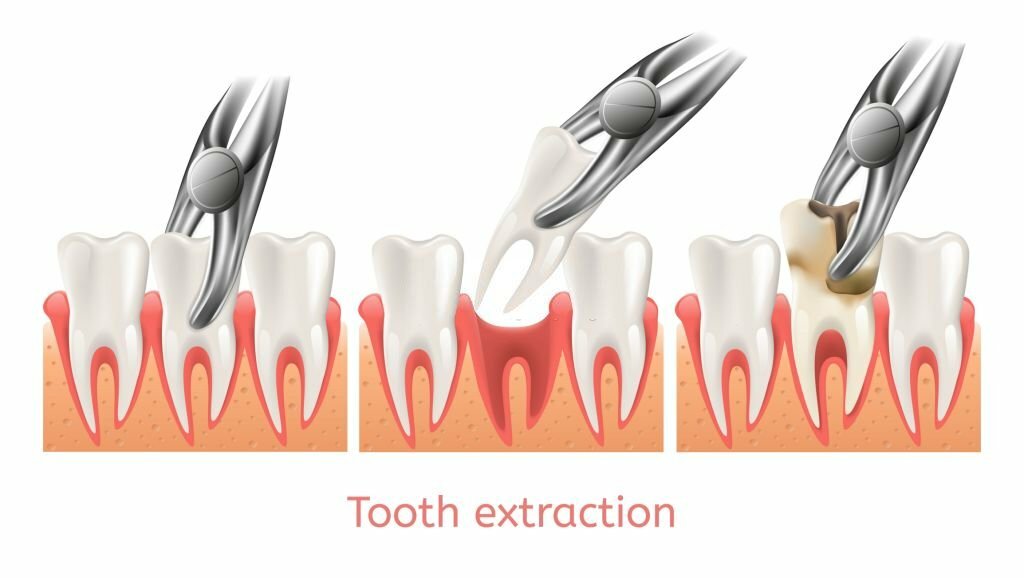Tooth extraction is inevitable!
Almost 74% of all adults need to undergo tooth extraction at least once in their lifetime.
Tooth extraction involves the removal of a tooth or a few teeth from its socket. Even though it may appear a bit daunting, tooth extraction is a fairly standard dental procedure.
In this blog, we take a closer look at:
- What is tooth extraction?
- Types of extractions.
- Procedure details of tooth extraction.
- Before/After a tooth extraction procedure.
The following sections explore different aspects of dental teeth pulling. Let’s get started!
Introduction:
Tooth extraction is the #1 dental procedure among individuals of all age groups. The procedure aims to redefine your smile and improve your overall oral health.
While oral health professionals generally avoid the complete removal of a tooth from its socket, sometimes, dental fillings or crowns aren’t enough to secure your oral health.
Your dentist might suggest tooth extraction if you have:
- Trauma or injury
- A fractured tooth.
- Severe tooth decay (cavities).
- Crowded teeth arrangement.
- Severe gum disease.
- Tooth luxation or other dental injuries.
However, extracting tooth with root canal is often the last stage of the procedure. Let’s learn more about the different conditions, methods, and different aspects of the treatment in the sections below.
The Two Types Of Extraction: What Goes Into The Preparation
Your current oral condition generally defines the type of extraction. Your dentist will analyze your medical and dental history and the necessary X-rays before pulling a tooth.
Based on the tooth’s shape, length, location, and surrounding bone density, your dentist will decide on any of the two removal procedures:
-
Simple Extractions:
Simple extractions are performed on teeth that are visible in your oral cavity. General dentists commonly perform such extractions under a local anesthetic, with or without sedation or anti-anxiety medications.
-
Surgical Extractions:
Surgical extraction is another approach for extracting teeth. Dentists or surgeons generally perform surgical extraction for teeth. They remove bone and raise and fold back all or part of the gum tissue to reveal the tooth or break the tooth into sections (called tooth sectioning).
Dentists carry out this method on teeth that can’t be seen or accessed or if you have chipped, broken teeth or molars that may not have completely erupted.
So now that we have an idea of the different procedures for the extraction of teeth, let’s have a quick overview of the process in action.
Tooth Extraction: What Happens During The Procedure
The tooth decay extraction procedure can be briefly divided into four different stages. The process generally begins with numbing your teeth and minimizing the swelling.

Here’s an overview of what the procedure looks like:
Stage 1: Numbing your tooth
During the first stage, your dentist will administer an anesthetic injection to numb the gum tissue, tooth, and bone surrounding the area. The injection is generally administered to minimize discomfort and pain during tooth extraction.
Based on the severity of your operation, your dentist will use any of these three anesthesia options:
- Nitrous Oxide: Also known as ‘laughing gas,’ nitrous oxide is a great alternative for individuals who require minimal sedation. Users opting for nitrous oxide are mostly in their senses and can travel alone to and from their appointments.
- Oral Conscious Sedation: This sedation is generally administered via the mouth as a pill, mainly triazolam, diazepam, lorazepam, and midazolam.
Oral conscious sedation can be paired with nitrous oxide or IV sedation. Individuals opting for this sedation need a friend or family member to drive them home after the procedure.
- Intravenous (IV) Sedation: The IV or Intravenous sedation is a good option for individuals with severe dental anxiety. They also work great for individuals who have to sit for lengthy procedures. Your dentist uses an IV line to introduce this sedation into the bloodstream.
IV sedation is the highest type, and patients opting for it require assistance returning home.
Stage 2: Extraction of the tooth
Once the oral cavity is numb, the dentist pulling teeth will use elevators and extraction forceps to remove the tooth from the socket. This process is relatively short and can take some time in rare cases.
Stage 3: Closing the space vacated by the tooth
Once the dentist removes the tooth, they clean the area and remove all the bone fragments from your oral cavity. The dentist sews up the gum tissue to avoid infection and stop bleeding. If there are any remaining bone pieces, the dentist may relieve discomfort and inflammation with medicine or remove them later.
Stage 4: Controlling bleeding and minimizing swelling
Once you clear and clean the area, place gauze over the extraction site, and apply pressure to halt bleeding (this may take up to an hour), your dentist will urge you.
After removing the gauze and normalizing the bleeding rate, the dentist may give you an ice pack to place on your cheek. This will help reduce swelling and inflammation. Depending on the healing speed, you may need to regularly apply an ice pack for up to 20 minutes for the first few days after the extraction.
Does Having Teeth Removed Hurt?
The pain behind tooth extraction is one common question that almost everyone has in mind.
While most teeth extraction procedures are pain-free and effortless, it completely depends on the complexity of your case. Most people feel the pain for a few hours after the extraction and return to their routine within 48 to 72 hours.
However, the jawbone typically takes many weeks, sometimes months, to recover. Therefore, you need to follow these tips for faster healing:
- Clean your extraction site wisely: Gently rinse the region with an antibacterial mouthwash twice or thrice daily. You should avoid brushing straight over your extraction site until your dentist says it’s safe. Brush and floss normally in all other places.
- Take all medications as directed: Take all your prescribed antibiotics and painkillers on time.
- Avoid strenuous activity for 48 hours: A higher heart rate might result in more post-operative bleeding and pain. Avoid the gym for the first 48 to 72 hours and consult your dentist to determine when it is safe to resume normal activities.
Takeaway
- Almost 74% of all adults need to undergo tooth extraction at least once in their lifetime.
- The tooth decay extraction procedure briefly divides into four different stages.
- Based on the severity of your operation, your dentist will give you three anesthesia options.
- The jawbone typically takes many weeks, sometimes months, to recover.

